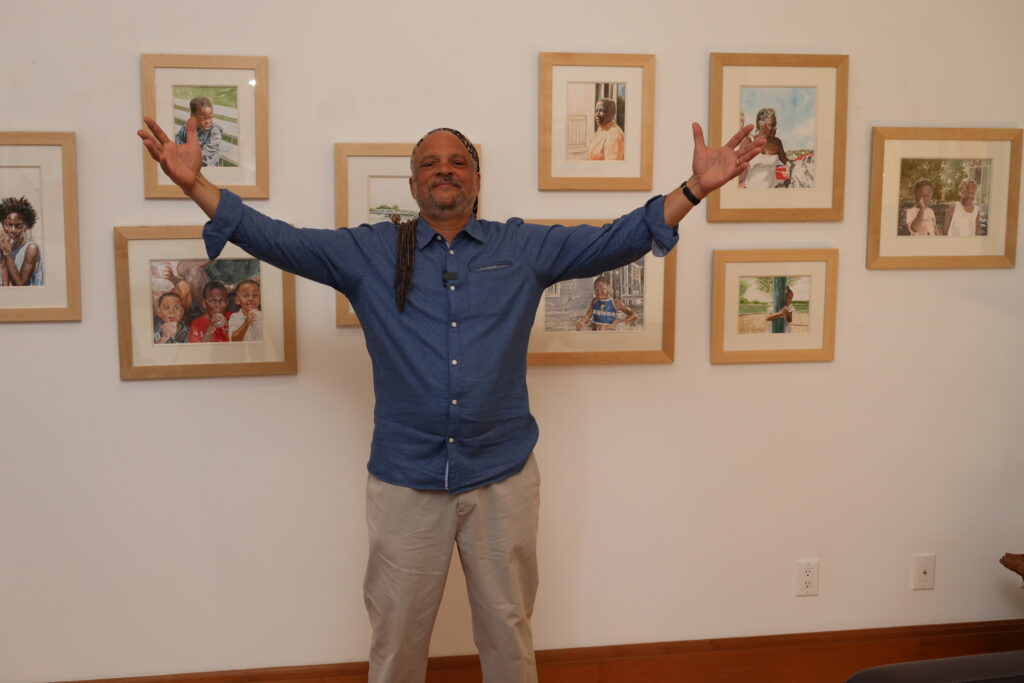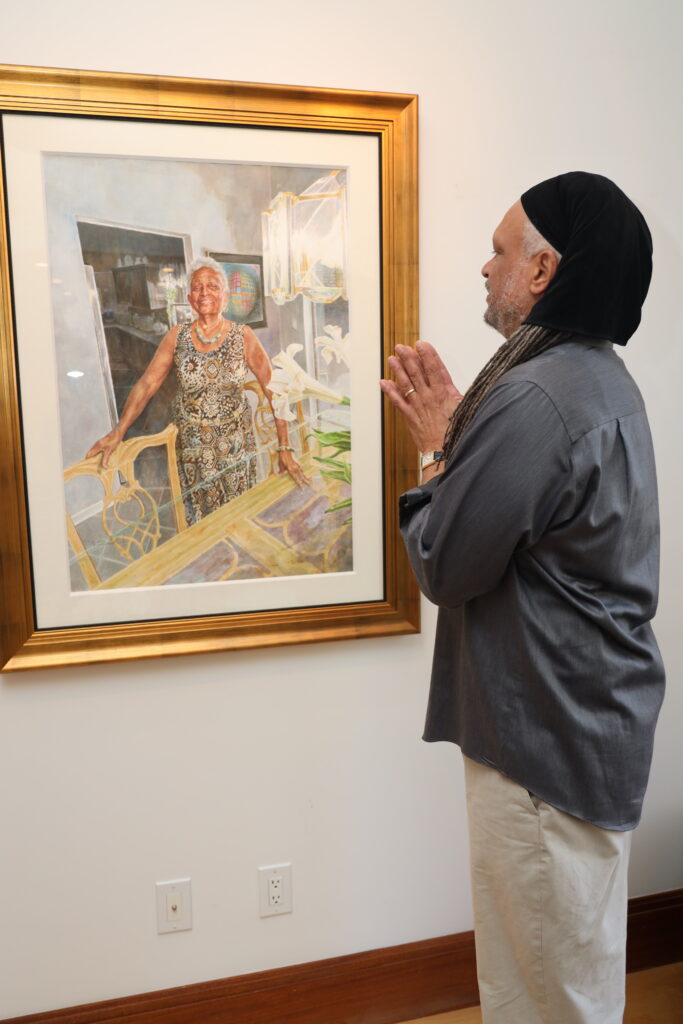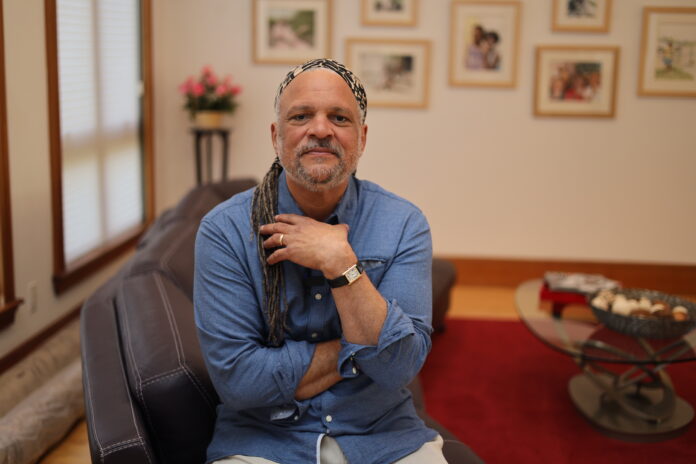( ENSPIRE Feature ) Philip Smallwood’s Lifescapes Mark an Important Institutional Change With Butler Institute Debut
ENSPIRE Contributor: Keegan Kerns
Philip Smallwood has been making waves in the art world for more than 20 years now, showcasing his own unique homegrown style of painting most frequently associated with his Lifescapes paintings. These Lifescapes, made using a signature watercolor style, combine portraiture with visual narrative, showing the subject in contrast to their environment in order to tell a deeper story about the complexities of their lives. This visual narrative format, provided by the Lifescape style, allows Smallwood’s paintings to reflect the experiences of a large variety of communities in a detailed and emotional way, allowing the viewer to more easily connect with the subject matter.
Philip Smallwood’s ability to create his own style to help represent the struggles of individuals, especially those within marginalized communities, is especially powerful and has rightfully earned him a great deal of respect throughout his career. As such, his paintings have been featured in numerous venues, including the Carol Craven Gallery in Martha’s Vineyard, the Bryant Gallery in New Orleans, and the Carolina Gallery in Charleston, among many others. Alongside his many artistic achievements, Philip Smallwood continues to work towards greater African-American representation in the art world. He seeks to provide avenues through which African-American artists can have greater access and opportunities when pursuing a career in art.

ENSPIRE had the opportunity to speak to Mr. Smallwood about his unique style of paintings as well as his future for a more equitable art world.
As an artist, you’re frequently with your watercolor paintings called Lifescapes, which combine portraiture and visual narrative. What drew you to this style of painting, and what special impact do you believe it has on the viewer?
I am very interested in portraying people in everyday life. Capturing an individual in a moment of time can be so simple, yet so powerful. I find that viewers make all kinds of connections to my subjects as they reflect on their own life’s journey. I enjoy the ability to portray emotions that depict the innocence of the young, and the wisdom of the elderly, and you will see that in my work, I tend to focus on these age demographics for this reason. You will also see the influence of my early years as an artisan in that architecture plays a key role in placing my subjects in front of some type of architecture. Finally, light is an extremely important element in my work to display the human element in its natural state and the sun is critical to placing the subjects in this favorable state.
One important focus of your career has been driving the message of understanding the importance and significance of Black artists and their legacy. What do you think the art world and broader society could do to give proper recognition to Black artists?
It’s really rather simple, it’s called giving black artists access that they have never had before. Sometimes timing is everything, and right now, the pandemic with all of its implications for social justice has presented a platform for this type of access and visibility. Until now, black artists have only represented about 4% of all museum exhibitions. It is my hope that these times have created a sustainable opportunity for many very talented black artists for now and the foreseeable future.
In the past decades with the rise of social media, how we communicate with each other has changed significantly, but so has how we view and share art. What has it been like as an artist navigating this cultural shift, and what benefits and negatives have you seen arise from this new system?
The benefit of social media is certainly the ability to reach a much larger audience both nationally and internationally. I just had my first virtual Open Studio, and the ability to reach people continues after the show, unlike a physical event where the event happens, and you are done. Social media allows us to create and sustain longer momentum for those interested in the work. I can actually see this happening after one week of the Virtual Opening. Every day, the number of viewers increases because of others sharing or following. It is exciting to be a part of this new normal and the new opportunities that have been created by social media.
Similarly, you’ve spoken more broadly about changing the narrative on art appreciation. What would you say the current narrative on art appreciation is, and how would you go about changing that narrative?
The narrative hasn’t changed much over the years, as there is a small sector of the population that truly appreciates, and collects art seriously, so it has always been about the ability to have access or be given the opportunity to have access. Once the doors open, there become more opportunities for black artists to also be validated by mainstream society.
Your works have been selected for a special exhibit at The Butler Institute this winter, which is a spectacular achievement. How does it feel to receive this recognition, both as an individual and as a Black artist, and where do you hope to go from here?
I am absolutely delighted to have been chosen for this rare opportunity. These are the opportunities that validate your work. Although the timing is everything, I will say that this opportunity came about based upon long-term relationships that I have garnered over the years with various museum art curators and CEOs. I am determined to continue my quest for other equally prestigious museum exhibits either nationally as well as abroad.

Philip Smallwood’s success within the art world is inspirational to us all. His achievements demonstrate his ability to overcome the barriers Black artists face in the art world. Besides this, he provides a figure for aspiring artists to emulate as they develop their own artistic styles and careers. Philip Smallwood’s own upcoming Butler Institute debut this December is an important landmark as well, as the Butler Institute was the first museum dedicated to American art. The continued representation of current Black artists can inspire future generations and hopefully contribute to a more level play-field as more doors open for Black artists.
You can learn more about Philip Smallwood and his artistic projects on his website, as well as his upcoming exhibition at the Butler Institute on their website.
Related Articles: Black Artists Create Designs Giving Back to Black Girls Code for Black History Month – Collaboration with Lifestyle Brand Erin Condren







